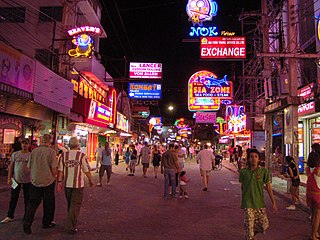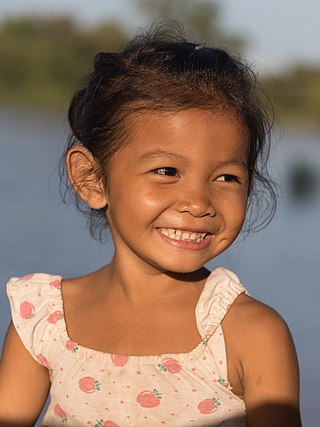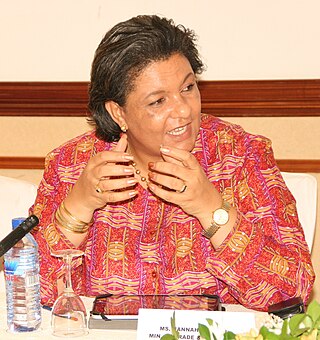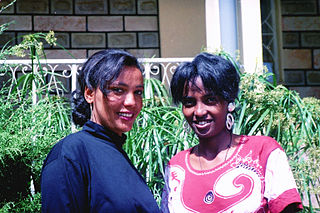Related Research Articles

Cameroon, officially the Republic of Cameroon, is a country in Central Africa. It shares boundaries with Nigeria to the west and north, Chad to the northeast, the Central African Republic to the east, and Equatorial Guinea, Gabon and the Republic of the Congo to the south. Its coastline lies on the Bight of Biafra, part of the Gulf of Guinea and the Atlantic Ocean. Due to its strategic position at the crossroads between West Africa and Central Africa, it has been categorized as being in both camps. Its nearly 27 million people speak 250 native languages, in addition to the national tongues of English and French, or both.

The hymen is a thin piece of mucosal tissue that surrounds or partially covers the vaginal opening. A small percentage are born with hymens that are imperforate and completely obstruct the vaginal canal. It forms part of the vulva and is similar in structure to the vagina. The term comes straight from the Greek, for 'membrane'.
Child marriage is a marriage or domestic partnership, formal or informal, between a child and an adult, or between a child and another child.
In medicine, precocious puberty is puberty occurring at an unusually early age. In most cases, the process is normal in every aspect except the unusually early age and simply represents a variation of normal development. In a minority of children with precocious puberty, the early development is triggered by a disease such as a tumor or injury of the brain. Even when there is no disease, unusually early puberty can have adverse effects on social behavior and psychological development, can reduce adult height potential, and may shift some lifelong health risks. Central precocious puberty can be treated by suppressing the pituitary hormones that induce sex steroid production. The opposite condition is delayed puberty.

Thelarche, also known as breast budding, is the onset of secondary breast development, often representing the beginning of pubertal development. It is the stage at which male and female breasts differentiate due to variance in hormone levels; however, some males have a condition in which they develop breasts, termed gynecomastia. Thelarche typically occurs between the ages of 8 and 13 years with significant variation between individuals. However, the initial growth of breast tissue occurs during fetal development.

Prostitution in Thailand is illegal. However, due to police corruption and an economic reliance on prostitution dating back to the Vietnam War, it remains a significant presence in the country. It results from poverty, low levels of education and a lack of employment in rural areas. Prostitutes mostly come from the northeastern (Isan) region of Thailand, from ethnic minorities or from neighbouring countries, especially Cambodia, Myanmar, and Laos. In 2019, UNAIDS estimated the total population of sex workers in Thailand to be 43,000.

Cameroon is a Central African nation on the Gulf of Guinea. Bantu speakers were among the first groups to settle Cameroon, followed by the Muslim Fulani until German domination in 1884. After World War I, the French took over 80% of the area, and the British 20%. After World War II, self-government was granted, and in 1972, a unitary republic was formed out of East and West Cameroon. Until 1976 there were two separate education systems, French and English, which did not merge seamlessly. French is now considered the primary language of instruction. Local languages are generally not taught as there are too many, and choosing between them would raise further issues.

A girl is a young female human, usually a child or an adolescent. When a girl becomes an adult, she is generally referred to as a woman. However, the term girl is also used for other meanings, including young woman, and is sometimes used as a synonym for daughter or girlfriend regardless of age. In certain contexts, the usage of the term girl for an adult woman may be considered derogatory. Girl may also be a term of endearment used by an adult, usually a woman, to designate adult female friends. Girl also appears in compounds like showgirl, cowgirl, and schoolgirl.

Forced marriage is a marriage in which one or more of the parties is married without their consent or against their will. A marriage can also become a forced marriage even if both parties enter with full consent if one or both are later forced to stay in the marriage against their will.

Violence against women (VAW), also known as gender-based violence and sexual and gender-based violence (SGBV), are violent acts primarily or exclusively committed by men or boys against women or girls. Such violence is often considered a form of hate crime, committed against women or girls specifically because they are female, and can take many forms.

Breast binding, also known as chest binding, is the flattening and hiding of breasts with constrictive materials such as cloth strips or purpose-built undergarments. Binders may also be used as alternatives to bras or for reasons of propriety.

Erotic lactation is sexual arousal by breastfeeding on a woman's breast. Depending on the context, the practice can also be referred to as adult suckling, adult nursing, and adult breastfeeding. Practitioners sometimes refer to themselves as being in an adult nursing relationship (ANR). Two persons in an exclusive relationship can be called a nursing couple.

The status of women in Ghana and their roles in Ghanaian society has changed over the past few decades. There has been a slow increase in the political participation of Ghanaian women throughout history. Women are given equal rights under the Constitution of Ghana, yet disparities in education, employment, and health for women remain prevalent. Additionally, women have much less access to resources than men in Ghana do. Ghanaian women in rural and urban areas face slightly different challenges. Throughout Ghana, female-headed households are increasing.

There have been several studies concerning women in Ethiopia. Historically, elite and powerful women in Ethiopia have been visible as administrators and warriors. This never translated into any benefit to improve the rights of women, but it had meant that women could inherit and own property and act as advisors on important communal and tribal matters. As late as the first part of the 20th century, Queen Menen, consort of Emperor Iyasu IV, had a decisive role in running the Ethiopian Empire. Workit and Mestayit regents to their minor sons have been held responsible for their provinces. They owed their rights to landed property because of a special type of land tenure that expected tenants to serve as militia to overlords, irrespective of gender. In 1896, Empress Tayetu Betul, wife of Emperor Menelik II, actively advised the government and participated in defending the country from Italian invasion. Prominent and other landowning women fought against the second invasion in 1935–41. With the assistance of European advisors, women in the ensuing period were kept out of the army and politics, even as advisors. Instead, they were restricted to family and household work of raising children and cooking. With a steady increase in female representation in education, they have started to undertake nursing, teaching, and other similarly supportive roles. Over the 2018–2019 period, their gradual participation in state politics has been increasing at a steady pace.
Prostitution in Cameroon is illegal but tolerated, especially in urban and tourist areas. In the capital, Yaoundé the main area of prostitution is the neighbourhood of Mini Ferme. UNAIDS estimate there are 112,000 sex workers in the country.

Surveys of victims of crime have been undertaken in many cities and countries, using a common methodology to aid comparability, and have generally included questions on sexual violence. The United Nations has conducted extensive surveys to determine the level of sexual violence in different societies. According to these studies, the percentage of women reporting having been a victim of sexual assault ranges from less than 2% in places such as La Paz, Bolivia (1.4%), Gaborone, Botswana (0.8%), Beijing, China (1.6%), and Manila, Philippines (0.3%), to 5% or more in Istanbul, Turkey (6.0%), Buenos Aires, Argentina (5.8%), Rio de Janeiro, Brazil (8.0%), and Bogota, Colombia (5.0%).

Violence against women in Guatemala reached severe levels during the long-running Guatemalan Civil War (1960-1996), and the continuing impact of that conflict has contributed to the present high levels of violence against women in that nation. During the armed conflict, rape was used as a weapon of war.
Child sexual abuse in Nigeria is an offence under several sections of chapter 21 of the country's criminal code. The age of consent is 18.
Gender inequality in Nepal refers to disparities and inequalities between men and women in Nepal, a landlocked country in South Asia. Gender inequality is defined as unequal treatment and opportunities due to perceived differences based solely on issues of gender. Gender inequality is a major barrier for human development worldwide as gender is a determinant for the basis of discrimination in various spheres such as health, education, political representation, and labor markets. Although Nepal is modernizing and gender roles are changing, the traditionally patriarchal society creates systematic barriers to gender equality.
References
- 1 2 3 4 5 6 7 8 9 10 11 12 Rebecca Tapscott (14 May 2012). "Understanding Breast "Ironing": A Study of the Methods, Motivations, and Outcomes of Breast Flattening Practices in Cameroon" (PDF). Feinstein International Center (Tufts University).
- 1 2 3 4 5 6 Randy Joe Sa'ah (23 June 2006). "Cameroon girls battle 'breast ironing'". BBC News . Retrieved 2008-01-02.
- 1 2 3 4 5 6 7 Ruth Gidley and Megan Rowling (7 July 2006). "Millions of Cameroon girls suffer "breast ironing"". AlertNet, Reuters. Archived from the original on May 21, 2010. Reproduced at the Child Rights Information Network. Retrieved 2011-04-02.
- 1 2 3 4 5 Sylvestre Tetchiada (13 June 2006). "An Unwelcome 'Gift of God'". IPS News . Retrieved 2008-01-02.
- 1 2 3 Vitalis Pemunta, Ngambouk (2016-11-30). "The Social Context of Breast Ironing in Cameroon". Athens Journal of Health. 3 (4): 335–360. doi: 10.30958/ajh.3-4-5 . ISSN 2241-8229.
- 1 2 3 Dugan, Emily (26 September 2013). "'Breast ironing': Girls 'have chests flattened out' to disguise the onset of puberty". Independent. London. Retrieved 27 September 2013.
- ↑ Lazareva, Inna (26 January 2019). "Revealed: 'dozens' of girls subjected to breast-ironing in UK". The Guardian. Retrieved 14 February 2019.
- ↑ Lazareva, Inna (13 February 2019). "Breast-ironing: UK government vows to tackle abusive practice". The Guardian. Retrieved 14 February 2019.
- 1 2 3 "Campaign launched to counter "breast ironing"". PlusNews. 28 June 2006. Archived from the original on 2012-02-13.
- ↑ Njume, Nkwelle Norbert Nicholas (2019). The Long-Term Health-Related Outcomes of Breast Ironing in Cameroon - ProQuest (Doctor of Philosophy in Public Health thesis). Walden University. ProQuest 2248747035.
- 1 2 Hussain M, Nzouankeu A (2013). "In Cameroon, women "iron" daughters' breasts to ward off men". Thomas Reuters Foundation.
- ↑ Nkepile Mabuse (July 27, 2011). "Breast ironing tradition targeted in Cameroon". CNN. Archived from the original on January 18, 2012. Retrieved 2012-02-17.
- 1 2 "Breast Ironing". Current TV. 26 February 2008. Archived from the original on April 10, 2008. Retrieved 2011-04-02.
- ↑ Rosaline Ngunshi Bawe (August 2011). "Breast Ironing... A harmful practice that has been silenced for too long" (PDF). Gender Empowerment and Development. Retrieved 14 February 2019.
- ↑ Irving Epstein; Leslie Limage (2008). The Greenwood encyclopedia of children's issues worldwide. Greenwood Publishing Group. p. 84. ISBN 978-0-313-33616-4 . Retrieved 2012-02-17.
- ↑ Vitalis Pemunta, Ngambouk (2016-11-30). "The Social Context of Breast Ironing in Cameroon". Athens Journal of Health. 3 (4): 335–360. doi: 10.30958/ajh.3-4-5 . ISSN 2241-8229.
- ↑ Vitalis Pemunta, Ngambouk (2016-11-30). "The Social Context of Breast Ironing in Cameroon". Athens Journal of Health. 3 (4): 335–360. doi: 10.30958/ajh.3-4-5 . ISSN 2241-8229.
- ↑ Penney, Joe. "Breast ironing". Reuters | The Wider Image. Retrieved 2020-09-03.